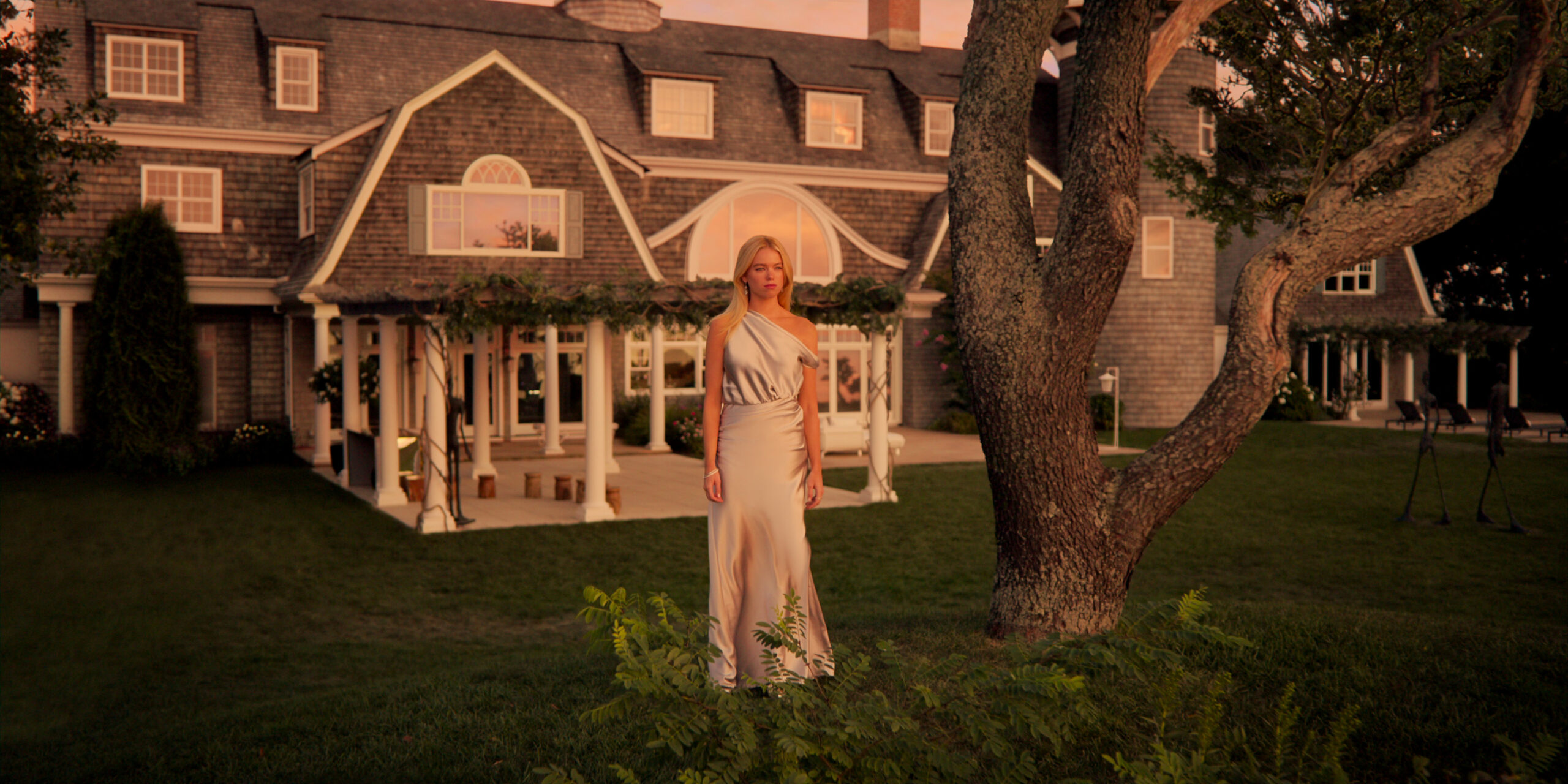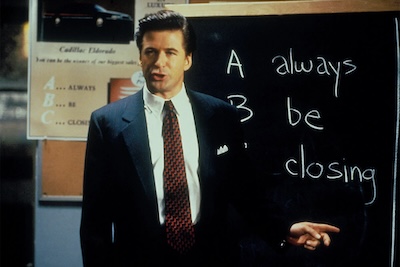You are not ready for the color explosions from the costume design of Netflix’s Sirens. You will need your sunglasses for more than shielding from the sun. In this world of luxury, privilege, and power, how you present yourself is everything, and when you stick out for the wrong reasons, you have more on the line than just the clothes on your back. For costume designer Caroline Duncan, Sirens was an opportunity to show how some of us grow and some of us shrink the version of ourselves that we want to leave behind, and the parade of color, silhouette, and personality is unmatched this season.
I joked with Duncan early in our conversation about the age-old command “You don’t wear white after Labor Day,” and that started a fascinating conversation about how Julianne Moore’s Michaela Kell is, in her mind and in the minds of her followers, a tastemaker. You throw out those traditions when someone you admire is pushing boundaries. Does Duncan think that any of these characters will wear white after this weekend?
“Oh, definitely,” she admits. “With Michaela, it’s hard to say, given her journey, but I think normally that rule does not apply. There are winter whites galore in the closet of New York City, and I do think that this is a world that is so thoughtfully curated by the people who populate it. If white is the most striking silhouette in winter, it’s going to be put on without a thought, because this is a world of rulemakers, so they cam be rule breakers.”
Michaela’s wardrobe reinforces her placement at the top but also how she got there. No one else dresses like her, and it’s not an accident. It’s almost as if her followers respect the hierarchy with how they dress. When Michaela is organizing and putting finishing touches on the Labor Day gala, she is in solid white with puffed up shoulders, a look, the designer explains, that is aspirational as much as it hints to how people look to her.

“It’s very architectural, and I like to think about what would she wants to see,” Duncan says. “Everyone is sort of dressing for her, and [figuring out] this cult sensibility is about how do we populate for one person centrally who is withdrawn from that world and connected at the same time? Was there an ascension where she was climbing through this social structure? Was she once a pastel like Simone? Or did she create these rules? We wanted to keep her connected to her followers but completely strikingly different from them at the same time. We kept her entirely in solids, and often a lot of white is visual pause from all the pastel, Easter egg explosion happening all around her. When we see Devon on the ferry, the other visitors feel almost like Stepford Wives with that saturation of sweet pastels. There’s also Nantucket in there–some of the Hamptons. As you get closer and closer to the inner circle, it starts to feel intentionally far more costumed.”
In the prologue for the series, Michaela walks out in early morning dresses in a flowy, green dress. We can’t see her feet, and we imagine that her feet are connected to the grass as she walks or we can envision the earth being pulled out of the ground every time we take a step. That green earthiness is reinforced in the clothing worn by the entire staff. Does that intention of green change with the Kell wealth? How much of it remains connected to the ground and how much is it connected to money and greed?
“The first time we see Michaela, she’s in green, and the staff lives in green,” she says. “That was intentional in her curation of that world, and I wanted her to feel connected to nature and feel almost like she was coming from the grass or from the woords. Nicole [Kassell], our director of the pilot, really liked that, and we landed on this shade. We had so many tones and shades of green in play, and when you hold that fabric up to Julianne’s skin, it was the clear winner. It has a slight iridescence to it, and Michaela is of the mind that she’s one of the people even though she’s clearly a classist. She exists in the same world of the staff in order to create this upstairs-downstairs visual dynamic.
The white look that she is wearing when she meets Devon for the first time was very intentional. We wanted her to look a bit like a deity. Sirens are clearly a theme running throughout, especially in the first two episodes before Devon truly understands this world. There’s an occult kind of eeriness to the whole place, so having Devon in black and Michaela in white–with everyone else in an explosion of color–creates a really good binary between the two of them.”
You cannot talk about Michaela without wondering what influence she has on Simone’s clothes. Of the main trio–Michaela, Devon, and Simone–we meet Milly Alcock’s character last, and she is the youngest. She spends the majority of the first episode in a short, bright, neon pink dress as she tries to keep her sister at bay while proving her worth at Michaela’s weekend event. It’s girly but pure (with the white accessories and accents), but Duncan shares how Simone’s costume expand on her growth, maturity, and ascension.
“[Creator] Molly Smith Metzler, Nicole, and I all agreed that she had to tbe the most committed member of this cult or this fan club from the minute that she is in front of Michaela,” Duncan says. “Her colors are dialed up more than everyone else’s, so she’s not really in pastels as much as aggressively hot pink. Simone is the neophyte of the group, and she’s in her hazing season–she has to prove her worth. It was intentional for me to start her out in something that felt young but also like a squeaky wheel that kind of brings attention to her. ‘Look at me! I’m doing everything perfectly!’ if you will. She is also dealing with a lot of mental illness, and she has that panic attack that indicates her bipolarity. I felt like putting her in this high-voltage pink and then shifting it slightly down in the next episode when she’s in the blue, and it continues down in terms of silhouette and color.

Simone has a moment in the series where her intentions change, so, at that point, we needed to find a way to show that through her carriage. In episode four, when she puts on an actual piece of Michaela’s clothing, that was very pivotal for us. What would Michaela select for her? What would she feel comfortable, in turn, in of Michaela’s? She puts on a pink sweater after that, before the reveal at the end, and that felt very iconic–kind of 1960s French film– to help the audience see her more of a woman and less of a little girl. We wanted to echo her psychology through her clothing starting in a really manic range and then graduating to the kind of dress that rivals Michaela’s when she takes her place at that podium. We built that dress to be like the same way when Devon met Michaela as the scepter moves over.”
When Fahy’s Devon is allowed to stay, she doesn’t have any clothes to wear, and she is given money to purchase something to look presentable. The scarlet dress fits her style. When she has to play nice at more public events, she is placed in a dress that signals how uncomfortable she is in her own body. Jose, the house’s manager, jokes about the bright colors by saying, ‘Does that dress come with batteries?’ Devon isn’t shy about showing her disdain for Michaela and how she flaunts her wealth, but this is a precise moment where costume design can be used to show power over someone else.
“I viewed it as a punishment for her,” Duncan admits. “The dress that she’s forced to wear is a vintage Lily Pulitzer fabric that I found, and then we built the dress in a birdcage–it’s called a cage dress, so there’s a lot to unpack there. It’s called that because it has those peekaboos right up at the neckline like a cage, but she does feel out of body in it. She’s imprisoned like she’s stuck there, but Devon is also trying to infiltrate so there were a lot of things we were trying to say by putting her in that silhouette. She has to stand out since she’s not part of the Vanity Fair photoshoot, and it has to feel like the greatest humiliation.
Think about, though, when she goes to boutique and is told to buy whatever she wants. Devon goes for this red dress that’s made out of ribbons. It looks almost exoskeletal, and, to her, that is luxury. For Devon, her luxury is vamp and power and something that feels sexual and slinky. It engages her core.”
If Duncan were to steal something for her own closet, she would have a lot to choose from. I admitted that I wanted the salmon duck suit jacket worn by Glenn Howerton’s Ethan Corbin III (the most uppity name ever?). I also envy the dark green of the staff’s neckties. Astrid, Chloe, and Lisa (The Fates as Duncan calls them; I kept referring to them as the Three Blind Mice) take their devotion to Michaela’s cause to the extreme with the wealth of color, and Catherine Cohen’s Lily-Rose (a nod to 2000s-era Lindsay Lohan or Paris Hilton) holds a special place for her. What would Duncan leave the island with?
“Ethan’s jacket was made by the woman who embroiders all of Tom Brown’s fabrics, because that’s a script point and ducky salmon fabric does not exist,” she says. “I love Lily Rose–she’s pure comedy gold. For her, I was looking at the party girls from my generation. For me, though, the obvious choice would be any piece of jewelry that Michaela wears. We work with the most incredible jewelry vendors, and they were so generous with us. Julianne is so beloved and the necklance that she wore, with the final gold gown, is sensational. The whole set is sensational.”
Sirens is streaming now on Netflix.









